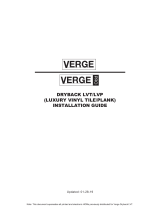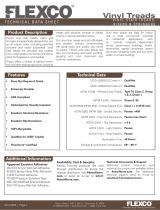Page is loading ...

DESCRIPTION
Primer T is a low-VOC, water-based acrylic primer that enhances the performance
and adhesion of self-leveling underlayments (SLUs) on nonabsorbent surfaces
such as ceramic tile, vinyl composition tile (VCT), epoxy moisture barriers and
adhesive residue, as well as profiled, absorbent surfaces. Suitable for a wide
variety of substrates, Primer T combines excellent versatility with an easy, low-
odor application.
FEATURES AND BENEFITS
• One-component, versatile primer for a wide variety of substrate
conditions
• Low odor and VOC compliance for safe use in interior, occupied
environments
• Single-coat application for faster turnaround and lower installation costs
• Easy handling and application
INDUSTRY STANDARDS AND APPROVALS
LEED Points Contribution LEED Points
MR Credit 5, Regional Materials* .................................................Up to 2 points
IEQ Credit 4.2, Low-Emitting Materials –
Paints & Coatings .....................................................................................1 point
* Using this product helps contribute to LEED certification of projects in the
categories shown above. Points are awarded based on contributions of all
project materials.
WHERE TO USE
• Use Primer T when applying a self-leveling underlayment on properly
prepared suitable substrates.
• Interior residential (apartments, condominiums and homes)
• Interior commercial (office buildings, hotel rooms and hallways,
restaurants and cafeterias)
• Interior heavy commercial (hotel lobbies, convention centers, airports,
shopping malls, grocery stores and department stores)
• Interior institutional (hospitals, schools, universities, libraries and
government buildings)
LIMITATIONS
• Do not install over any substrates containing asbestos.
• Substrate and ambient temperatures must be between 50°F to 90°F
(10°C to 32°C).
• In all cases, the surface temperature of the prepared concrete slab must
be at least 5°F (2,8°C) above the dew point to avoid condensation on the
concrete surface as Primer T dries.
• Protect from freezing.
• For moisture limits on this primer, refer to the moisture limits of the
product to be applied over it.
• Verify that the substrate is free of bond-inhibiting or bond-breaking
materials such as curing compounds and dust.
• For use only in dry, interior environments. Do not apply on wet substrates.
All-Purpose Primer
for Self-Leveling
Underlayments
Primer T
™
Primer T
™
Version: Oct 10, 2017

• Use undiluted over moisture-stable, exterior-grade
plywood.
• Use undiluted over dense, nonabsorbent surfaces,
such as epoxy moisture barriers, floor-covering
adhesive residue, and properly prepared ceramic tile
and VCT.
• Dilute the product for application over absorbent,
porous substrates at a ratio of 1:1 to 2:1 (water to
primer).
SUITABLE SUBSTRATES
• Properly prepared and bonded tile, stone and VCT
• Properly prepared and installed 100%-solids epoxy
moisture barriers
• Epoxy cement terrazo and poured epoxy flooring
• Cement backer units (CBUs)
• Substrates with traces of well-adhered, water-resistant
glue (cutback adhesive, floor-covering adhesive or
polyurethane adhesive)
• Dimensionally stable exterior-grade plywood
• Properly prepared sound and stable concrete
substrates, whether smooth and nonabsorbent
or profiled and absorbent
• Use over gypsum-based SLUs that are free of gypsum
dust before application of cementitious or gypsum-
based SLUs.
Consult MAPEI’s Technical Services Department for
installation recommendations regarding any substrates
and conditions not listed.
SURFACE PREPARATION
• All substrates must be interior, structurally sound, dry,
solid and stable.
• Mechanically prepare existing ceramic, quarry and
porcelain tile, as well as cement terrazzo.
• Thoroughly clean all surfaces of any substance that
could interfere with the bond of the installation material,
including dirt, paint, tar, asphalt, wax, oil, grease, latex
compounds, sealers, curing compounds, form release
agents, laitance, loose toppings, foreign substances,
and poorly bonded adhesive residues.
• Do not acid-etch surfaces before applying Primer T.
• When applying MAPEI underlayments to plywood
flooring or oriented strand board (OSB), the installation
specifics (finished flooring, load, use and/or deflection)
may require the use of MAPEI’s Mapelath
™
or diamond
mesh (meeting the requirements of ASTM C847) on
top of the primed surface before application of the
underlayment. In all cases, one can anticipate better
performance when utilizing lath, particularly over
OSB. Refer to Mapelath’s current Technical Data Sheet
for installation instructions. Differential or excessive
movement within a plywood substrate may lead to
hairline cracks at plywood joints.
MIXING
Note: Choose all appropriate safety equipment before use.
Refer to the Safety Data Sheet for more information.
1a. Over nonabsorbent surfaces: Apply Primer T undiluted.
(Add no water; no mixing is required.)
1b. Over porous, absorbent surfaces (typically absorbent,
profiled concrete substrates): Dilute Primer T with water
at a ratio of 1:1 to 2:1 (water to primer). Mix with water
in a separate clean container with a low-speed mixer
and paddle to a homogenous consistency. Do not mix
at high speeds, which may cause product foaming.
1c. Over gypsum substrates: Dilute at a ratio of 2:1 (water
to primer). Mix as indicated in Step 1b and apply two
coats if required by visual inspection. Ensure that the
gypsum substrate is sound and free of gypsum dust.
PRODUCT APPLICATION
Note: Read all installation instructions thoroughly before
installation.
1. Apply the product with a 3/8" (10 mm) nap roller. Ensure
that the surface receives a complete, thin film of product.
2a. Nonabsorbent substrates and wood require only one
coat of undiluted Primer T.
2b. Absorbent and gypsum substrates may require more
than one coat of diluted Primer T to seal off the substrate
and prevent substrate outgassing.
3. The underlayment can typically be applied within 2 to
5 hours (see the “Shelf Life and Application Properties”
table). Drying times will vary depending on the porosity
of the surface, temperature and humidity. The maximum
wait time from initial application is 24 hours.
4. If the dried Primer T remains uncovered for more than
24 hours, re-apply a second, undiluted coat and install
the underlayment within the correct application window
(see the “Shelf Life and Application Properties” table).
If the application window is missed again, remove the
primer mechanically and start the installation on the
clean substrate.
CLEANUP
• Clean equipment immediately with water. Mineral spirits
may be used to remove primer that has dried on tools.
Pri
mer
T
™
Pri
mer
T
™

Product Performance Properties at 73°F (23°C) and 50% relative humidity
Laboratory Tests Results
Polymer type Acrylic
Percent solids 43% to 45%
VOCs 92 g per L
pH 7 to 8
Viscosity (RV2 @ 20 rpm) 1,400 cps
Density 64.2 lbs. per cu. ft. (1,03 g per cm
3
)
Consistency Pourable liquid
Color White
Application temperature range 50°F to 90°F (10°C to 32°C)
Shelf Life and Application Properties at 73°F (23°C) and 50% relative humidity
Shelf life
2 years when stored in original, unopened packaging in
a dry, covered location
Window for application of SLU at 73°F (23°C)
2 to 3 hours of drying time up to 24 hours from application
over porous substrates (concrete, wood and gypsum); 4 to
5 hours of drying time up to 24 hours from application over
nonporous substrates (ceramic and VCT)
Flash point (Seta) > 212°F (100°C)
CSI Division Classication
Cast Underlayment 03 54 00
Packaging
Size
1 U.S. qt. (946 mL)
2 U.S. gals. (7,57 L)
Approximate Coverage*
Typical Application Tool Coverage
3/8" (10 mm) nap roller
2 U.S. gals. (7,57 L): 400 to 800 sq. ft. (37,2 to 74,3 m
2
)
1 U.S. qt. (946 mL): 50 to 100 sq. ft. (4,65 to 9,29 m
2
)
* Coverage depends on the substrate profile and porosity.
Pri
mer
T
™
Pri
mer
T
™

We proudly support the following industry organizations:
MAPEI Headquarters of North America
1144 East Newport Center Drive
Deerfield Beach, Florida 33442
1-888-US-MAPEI (1-888-876-2734) /
(954) 246-8888
Technical Services
1-800-992-6273 (U.S. and Puerto Rico)
1-800-361-9309 (Canada)
Customer Service
1-800-42-MAPEI (1-800-426-2734)
Services in Mexico
0-1-800-MX-MAPEI (0-1-800-696-2734)
Edition Date: October 11, 2017
PR: 5778 MKT: 17-2327
For the most current BEST-BACKED
SM
product data and warranty information, visit www.mapei.com.
All Rights Reserved. Printed in the USA. © 2017 MAPEI Corporation.
Refer to the SDS for specific data related to health and safety as
well as product handling.
LEG A L NOTICE
The contents of this Technical Data Sheet (“TDS”)
may be copied into another project-related
document, but the resulting document shall not
supplement or replace requirements per the
TDS in effect at the time of the MAPEI product
installation. For the most up-to-date TDS and
warranty information, please visit our website at
www.mapei.com. ANY ALTERATIONS TO THE
WORDING OR REQUIREMENTS CONTAINED
IN OR DERIVED FROM THIS TDS SHALL
VOID ALL RELATED MAPEI WARRANTIES.
Before using, the user must determine the
suitability of our products for the intended use,
and the user alone assumes all risks and liability.
ANY CLAIM SHALL BE DEEMED WAIVED
UNLESS MADE IN WRITING TO US WITHIN
FIFTEEN (15) DAYS FROM DATE IT WAS,
OR REASONABLY SHOULD HAVE BEEN,
DISCOVERED.
Pri
mer
T
™
Pri
mer
T
™
/







